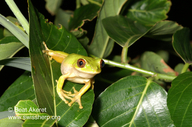|
Leptopelis natalensis (Smith, 1849)
Natal Tree Frog, Isele lasezihlahleni laseNatali (Zulu) | family: Arthroleptidae genus: Leptopelis |
| Species Description: Smith, A. 1849. Illustrations of the Zoology of South Africa; Consisting Chiefly of Figures and Descriptions of the Objects of Natural History Collected during an Expedition into the Interior of South Africa, in the Years 1834, 1835, and 1836 .... Vol. III. Reptilia. Appendix. London: Smith, Elder, & Co. | |
 © 2008 Dr. Beat Akeret (1 of 11) |
|
|
|
|



 Map of Life
Map of Life